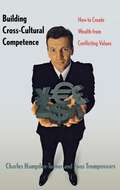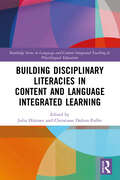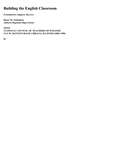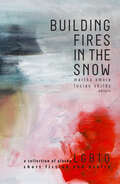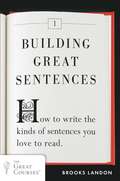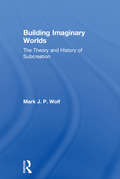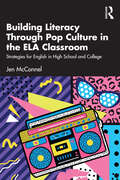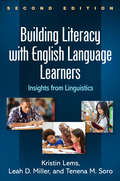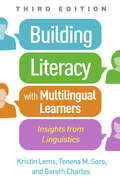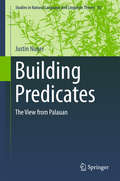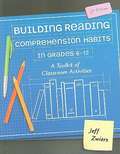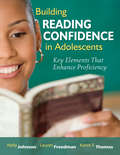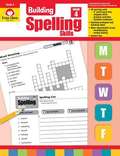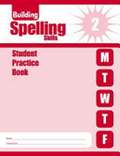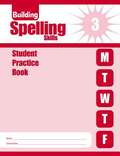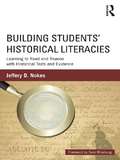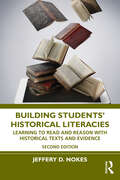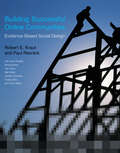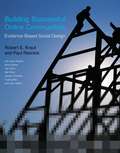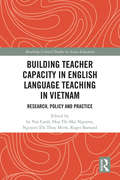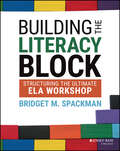- Table View
- List View
Building Cross-Cultural Competence: How to Create Wealth from Conflicting Values
by Charles Hampden-Turner Fons Trompenaars David LewisBased on 14 years of research involving nearly 50,000 managerial respondents and on the authors' extensive experience in international business, this book uses humor, cartoons, and numerous business examples to show managers how to reconcile cultural differences in the workplace.
Building Disciplinary Literacies in Content and Language Integrated Learning (Routledge Series in Language and Content Integrated Teaching & Plurilingual Education)
by Julia Hüttner Christiane Dalton-PufferHüttner and Dalton-Puffer present research demonstrating the tangible benefits of the long-term sustainability of Content and Language Integrated Learning (CLIL) on participants’ educational outcomes.The chapters outline the argument that the main benefit of CLIL lies in the fact that learners acquire specific literacy practices linked to the curricular subjects they study via the CLIL language and that these go beyond what is commonly learned and studied within a foreign language curriculum. The book provides an orientation as to how such disciplinary literacy or literacies can be conceptualised and understood, and introduces several models that have served to make disciplinary literacies graspable and visible. The various chapters showcase research and development projects from different geographical and educational contexts and therefore elaborate ideas around disciplinary literacies from different vantage points.This book aims at a wide and varied readership, including graduate students studying applied linguistics, foreign language education, and/or teaching methodology; language teachers; content subject teachers with an interest in the linguistic side of their subject; and teacher trainers.
Building The English Classroom: Foundations, Support, Success
by Bruce M. PennimanAfter nearly four decades in the classroom, Bruce M. Penniman knows what works (and what doesn't!) when it comes to teaching English. Penniman draws on his own experiences--his successes, of course, but also the mistakes he's made and the misgivings he's had--to offer guidance and support for managing the myriad demands of teaching secondary English. From addressing the numerous subdisciplines within English to making individual accommodations, from dealing with being the primary locus of literacy instruction in the school to everyday organizational strategies, Penniman helps teachers find a way to impose order on what often seems like an overwhelming array of responsibilities. Focusing on all aspects of building a successful English classroom, Penniman offers unique and proven strategies on topics such as planning for the long term; designing writing programs and literature curricula; creating effective assessment systems; implementing instructional strategies for writing, literature, media/technology, and "basic skills"; examining the curriculum through the lens of multiculturalism; attending to the needs of all students--especially those who require accommodations; giving back to the profession and pursuing a professional life outside the classroom.
Building English Skills (Brown Level)
by Frances Freeman Paden Susan Duffy Schaffrath Sandra D. Wittenbrink3rd grade textbook
Building Fires in the Snow: A Collection of Alaska LGBTQ Short Fiction and Poetry
by Amore, Martha; Childs, LucianDiversity has always been central to Alaska identity, as the state’s population consists of people with many different backgrounds, viewpoints, and life experiences. This book opens a window into these diverse lives, gathering stories and poems about lesbian, gay, bisexual, transgender, and queer life into a brilliant, path-breaking anthology. In these pages we see the panoply of LGBTQ life in Alaska today, from the quotidian urban adventures of a family—shopping, going out, working—to intimate encounters with Alaska’s breathtaking natural beauty. At a time of great change and major strides in LGBTQ civil rights, Building Fires in the Snow shows us an Alaska that shatters stereotypes and reveals a side of Alaska that’s been little seen until now.
Building Great Sentences
by Brooks LandonBased on the bestselling series from The Great Courses, Building Great Sentences celebrates the sheer joy of language--and will forever change the way you read and write. Great writing begins with the sentence. Whether it's two words ("Jesus wept. ") or William Faulkner's 1,287-word sentence in Absalom! Absalom!, sentences have the power to captivate, entertain, motivate, educate, and, most importantly, delight. Yet, the sentence-oriented approach to writing is too often overlooked in favor of bland economy. Building Great Sentences teaches you to write better sentences by luxuriating in the pleasures of language. Award-winning Professor Brooks Landon draws on examples from masters of long, elegant sentences--including Don DeLillo, Virginia Woolf, Joan Didion, and Samuel Johnson--to reveal the mechanics of how language works on thoughts and emotions, providing the tools to write powerful, more effective sentences. .
Building Imaginary Worlds: The Theory and History of Subcreation
by Mark J.P. WolfMark J.P. Wolf’s study of imaginary worlds theorizes world-building within and across media, including literature, comics, film, radio, television, board games, video games, the Internet, and more. Building Imaginary Worlds departs from prior approaches to imaginary worlds that focused mainly on narrative, medium, or genre, and instead considers imaginary worlds as dynamic entities in and of themselves. Wolf argues that imaginary worlds—which are often transnarrative, transmedial, and transauthorial in nature—are compelling objects of inquiry for Media Studies. Chapters touch on: a theoretical analysis of how world-building extends beyond storytelling, the engagement of the audience, and the way worlds are conceptualized and experienced a history of imaginary worlds that follows their development over three millennia from the fictional islands of Homer’s Odyssey to the present internarrative theory examining how narratives set in the same world can interact and relate to one another an examination of transmedial growth and adaptation, and what happens when worlds make the jump between media an analysis of the transauthorial nature of imaginary worlds, the resulting concentric circles of authorship, and related topics of canonicity, participatory worlds, and subcreation’s relationship with divine Creation Building Imaginary Worlds also provides the scholar of imaginary worlds with a glossary of terms and a detailed timeline that spans three millennia and more than 1,400 imaginary worlds, listing their names, creators, and the works in which they first appeared.
Building Literacy Through Pop Culture in the ELA Classroom: Strategies for English in High School and College
by Jen McConnelDesigned to support English-teaching faculty across high schools and universities, this practical guide presents novel ideas for integrating pop culture into ELA classroom instruction.By establishing a theoretical framework rooted in critical and digital literacies, this book provides a solid foundation for preservice and college teachers to tap into the pop culture that inspires and engages students and teachers alike. Enacting as an essential text for courses in literature instruction and ELA methods, McConnel offers strategies and research-based tools to blend film, fanfiction, and other popular multimodal texts in ways that will reenergize the curriculum, meet standards-based goals, and motivate students.Building Literacy Through Pop Culture in the ELA Classroom is an innovative textbook that belongs on the shelves of current and aspiring English instructors.
Building Literacy with English Language Learners, Second Edition: Insights from Linguistics
by Kristin Lems Leah D. Miller Tenena M. SoroHow can linguistics help teachers of English language learners (ELLs) improve their instruction? What specific competencies do ELLs need to build in order to speak, listen, read, and write in a new language? Now revised and expanded with a broader view of literacy, this book has guided thousands of inservice and preservice teachers to understand the processes involved in second-language acquisition and help ELLs succeed. The authors explain relevant linguistic concepts with a focus on what works in today's diverse PreK-12 classrooms. Effective teaching strategies are illustrated with engaging classroom vignettes; the volume also features instructive discussion questions and a glossary. (First edition title: Teaching Reading to English Language Learners.) New to This Edition *Chapter on digital learning, plus new content on digital technology throughout the book. *Broader view of literacy; increased attention to oral language and writing as well as reading. *Even more user friendly--additional classroom suggestions from real teachers, vignettes, and examples and graphics illustrating linguistic concepts. *End-of-chapter "challenge questions" that inspire deeper reflection. *Coverage of timely topics, such as numeracy and the language innovations of text messages. This e-book edition features 18 full-color figures. (Figures will appear in black and white on black-and-white e-readers).
Building Literacy with Multilingual Learners: Insights from Linguistics
by Kristin Lems Tenena M. Soro Gareth CharlesNow in a revised and expanded third edition, this established course text and teacher guide explores the processes involved in second-language acquisition and translates the research into practical instructional strategies for PreK–12. Engaging classroom vignettes and personal reflections from the authors and other seasoned educators bring the teaching methods and linguistic concepts to life. Highlighting ways to draw on emergent bilingual and multilingual students' strengths, the book presents innovative learning activities, lesson-planning ideas, technology applications, downloadable reproducible forms, and other resources. Second edition title: Building Literacy with English Language Learners. New to This Edition *Chapter on visual literacy. *Extensive updated coverage of literacy in the digital age, including gamification and video games, digital reading, and uses of ChatGPT in the classroom. *Increased attention to multimodal projects and activities. *New or expanded discussions of translanguaging, dual-language instruction, English as a lingua franca as well as an academic language, and other timely topics. Pedagogical Features *"How Does This Look in the Classroom?" sections. *Study and discussion questions in every chapter. *Chapter-opening "Key Vocabulary" boxes. *End-of-book glossary.
Building Poems
by Michael Clay ThompsonUses architecture as an extended metaphor, showing that poems are constructed like buildings and with careful attention to every detail
Building Power in Reading and Writing
by Henry I. ChristPart One reviews all the reading skills you will need either to take tests Part Two reviews common usage errors Part Three reviews writing skills Part Four is a thorough review of both reading and writing skills
Building Predicates: The View from Palauan (Studies in Natural Language and Linguistic Theory #92)
by Justin NugerThis volume provides a comprehensive analysis of the syntax of Palauan that will appeal to anyone interested in Austronesian languages or formal syntactic and morphological theory. This volume proposes that words in Palauan are not drawn directly from a mental lexicon, but are instead composed at least partially in the syntax. Using original data from syntactic constructions not previously explored in the language, the author entertains several competing theories of word formation and highlights the compatible and incompatible aspects of each, through an exploration into new corners of Palauan syntax and morphology.
Building Reading Comprehension Habits in Grades 6-12: A Toolkit of Classroom Activities (Second Edition)
by Jeff ZwiersThis second edition succinctly describes practical ideas, including more than 15 new activities, which have been working in a wide range of middle school and high school classrooms. The author has used the ideas, seen them used by others, and researched their effectiveness in a variety of settings.
Building Reading Confidence in Adolescents: Key Elements That Enhance Proficiency
by Holly A. Johnson Lauren Freedman Karen F. ThomasThe authors present a research-based approach for building reading self-efficacy and focus on four concepts necessary to learners' literacy success: confidence, independence, metacognition, and stamina.
Building Spelling Skills (Grade #4)
by Evan-MoorThe book provides students with frequent, focused skills practice. The reproducible format and additional teacher resources provide everything needed to help students master and retain basic skills.
Building Spelling Skills Grade 2 Student Book
by Evan-Moor Educational Publishers StaffIn Building Spelling Skills Daily Practice, Grade 2, students will learn 10 spelling words per week (300 total). Two sentences for dictation are provided for each list. This title includes spelling lists, practice pages, and reproducible forms.
Building Spelling Skills, Student Practice Book, Grade 3
by Evan-Moor Educational Publishers StaffIn Building Spelling Skills Daily Practice, Grade 3, students will learn 15 spelling words per week (450 total). Three sentences for dictation are provided for each list. This title includes spelling lists, practice pages, and reproducible forms.
Building Students' Historical Literacies: Learning to Read and Reason with Historical Texts and Evidence
by Jeffery NokesHow can teachers incorporate the richness of historical resources into classrooms in ways that are true to the discipline of history and are pedagogically sound? This book explores the notion of historical literacy, adopts a research-supported stance on literacy processes, and promotes the integration of content-area literacy instruction into history content teaching. It is unique in its focus on the discipline-specific literacies of historical inquiry. Addressing literacy from a historian’s rather than a a literacy specialist’s point of view, this book surveys a broad range of texts including those that historians and non-historians both use and produce in understanding history; and includes a wide variety of practical instructional strategies immediately available to teachers. History teachers who read this book will receive the practical tools they need in order to help their students reach the national standards for history teaching. With the recent inclusion of a historical literacy component of the English Language Arts Common Core Standards Initiative, this book is also highly relevant to English, language arts, and reading teachers, who are expected, under the new guidelines, to engage their students in historical reading and writing. Visit historicalliteracies.byu.edu for additional information and resources on teaching historical literacies.
Building Students' Historical Literacies: Learning to Read and Reason With Historical Texts and Evidence
by Jeffery D. NokesHow can teachers incorporate the richness of historical resources into classrooms in ways that are true to the discipline of history and are pedagogically sound? Now in its second edition, this book explores the notion of historical literacy, adopts a research-supported stance on literacy processes, and promotes the integration of content-area literacy instruction into history content teaching. Providing an original focus on the discipline-specific literacies of historical inquiry, the new edition presents a deeper examination of difficult histories and offers new strategies that can be applied to all genres of historical inquiry. Nokes surveys a broad range of texts, including those that historians and nonhistorians both use and produce in understanding history, and provides a wide variety of practical instructional strategies immediately available to teachers. Featuring new examples and practical resources, the new edition highlights the connection between historical literacies and the critical reading and communication skills that are necessary for informed civic engagement. Equipped with study guides, graphic organizers, and scoring guides for classroom use, this text is an essential resource for preservice and practicing teachers in literacy and social studies education.
Building Successful Online Communities: Evidence-Based Social Design (The\mit Press Ser.)
by Paul Resnick Robert E. KrautHow insights from the social sciences, including social psychology and economics, can improve the design of online communities.Online communities are among the most popular destinations on the Internet, but not all online communities are equally successful. For every flourishing Facebook, there is a moribund Friendster—not to mention the scores of smaller social networking sites that never attracted enough members to be viable. This book offers lessons from theory and empirical research in the social sciences that can help improve the design of online communities.The authors draw on the literature in psychology, economics, and other social sciences, as well as their own research, translating general findings into useful design claims. They explain, for example, how to encourage information contributions based on the theory of public goods, and how to build members' commitment based on theories of interpersonal bond formation. For each design claim, they offer supporting evidence from theory, experiments, or observational studies.
Building Successful Online Communities: Evidence-Based Social Design
by John Riedl Joseph Konstan Moira Burke Niki Kittur Paul Resnick Robert E. Kraut Sara Kiesler Yan Chen Yuqing RenOnline communities are among the most popular destinations on the Internet, but not all online communities are equally successful. For every flourishing Facebook, there is a moribund Friendster -- not to mention the scores of smaller social networking sites that never attracted enough members to be viable. This book offers lessons from theory and empirical research in the social sciences that can help improve the design of online communities.The authors draw on the literature in psychology, economics, and other social sciences, as well as their own research, translating general findings into useful design claims. They explain, for example, how to encourage information contributions based on the theory of public goods, and how to build members' commitment based on theories of interpersonal bond formation. For each design claim, they offer supporting evidence from theory, experiments, or observational studies.
Building Teacher Capacity in English Language Teaching in Vietnam: Research, Policy and Practice (Routledge Critical Studies in Asian Education)
by Le Van Canh Hoa Thi Mai Nguyen Nguyen Thi Thuy Minh Roger BarnardThis timely volume opens a window on issues related to English language education in Vietnam. The authors consider that teacher quality is the key factor to be considered if the national English language curriculum outcomes are to be achievable. Aiming to shed light on key issues recently observed in the Vietnamese landscape of English language education, it examines the complexity of the institutionalization of the standardized English proficiency policy, which has been in force since 2008. That policy uses the Common European Framework of References for Languages (CEFR) as the model to set the standards and levels of proficiency for teachers, learners and state employees. The book presents both the theoretical and practical aspects of the standardization movement in English language education. The contents comprise a series of extended research-based chapters written by experts of language-in-education policy and planning in and about Vietnam from a range of perspectives including teachers, English language curriculum developers, teacher educators and researchers. The rich coverage of the book includes current discussion on English language education in Vietnam ranging from policy to practice, making it highly relevant to English teachers, teacher educators, and scholars, in Vietnam and worldwide, who aspire to broaden their horizons and professionalism.
Building the Literacy Block: Structuring the Ultimate ELA Workshop
by Bridget M. SpackmanTransform the way your students engage with learning during your literacy block. In Building the Literacy Block: Structuring the Ultimate ELA Workshop, veteran public-school educator Bridget Spackman delivers an insightful and practical discussion on establishing an authentic and purposeful workshop model while integrating reading and writing instruction to create a rigorous environment for all learners. Every chapter of the book focuses on an individual element of your literacy block, provides example activities, and offers practical tips on how to accommodate a variety of classroom environments, ages, and learners. Readers will also find: Explorations of the essential elements of establishing a strong literacy block and the process necessary for educators to implement this method of instruction Simple and effective strategies for building critical thinking and lifelong learning skills Techniques rooted in modern instructional practices designed to help educators develop authentic learning experiences for all students. A powerful tool that offers upper elementary teachers methods for establishing an authentic and rigorous literacy block, Building the Literacy Block is a must-have resource for 3-6 literacy educators as well as those who work directly or indirectly with students, teachers, and school administrators.
